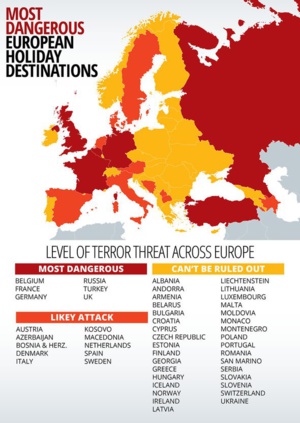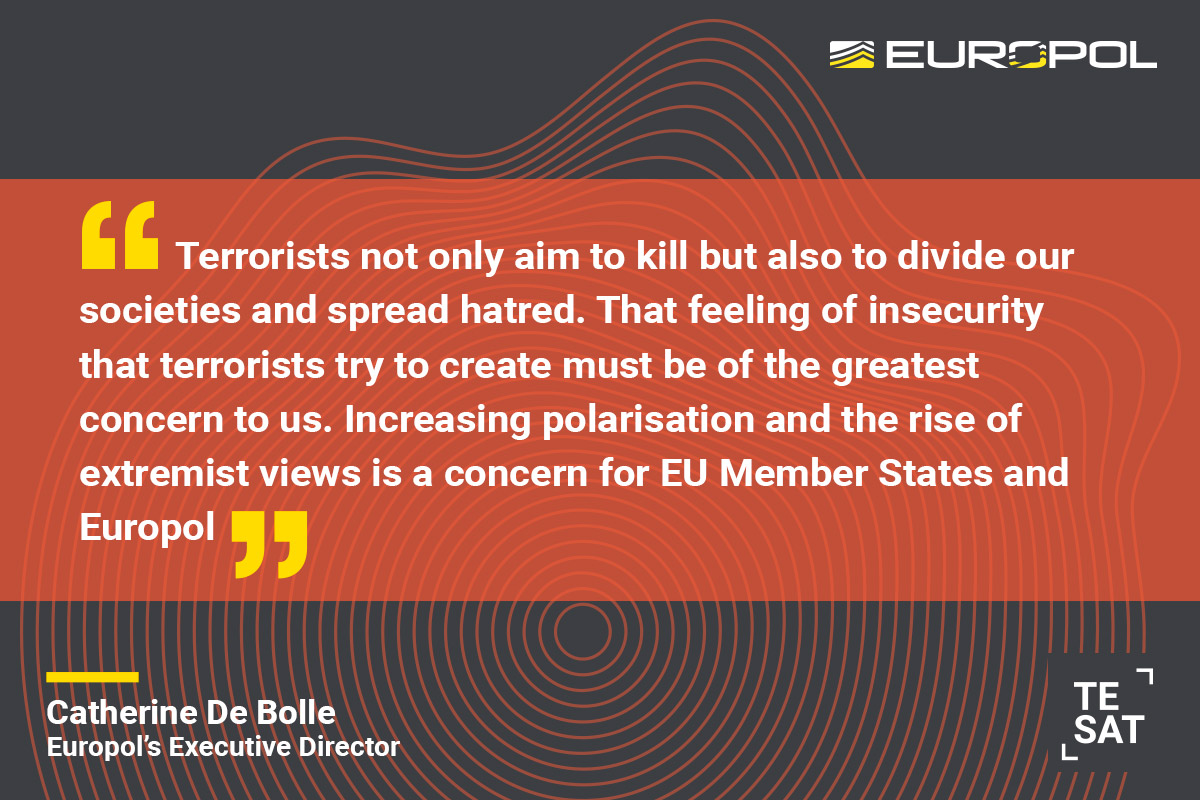Europol’s 2019 EU Terrorism Situation and Trend Report (TE-SAT), a product requested by the European Parliament and published today, provides a concise overview of the nature of the terrorist threat the EU faced in 2018.

Source: Daily Express. Holidays 2019: The FCO has mapped the most dangerous holiday destinations in Europe
New EU Terrorism Situation and Trend Report describes terrorist incidents and activities on European soil.
In 2018, terrorism continued to represent a major security threat in EU Member States. Horrific attacks killed thirteen people and injured many more. A stark increase in the number of arrests linked to right-wing extremism, although still relatively low, indicates that extremists of diverging orientation increasingly consider violence as a justified means of confrontation. Compared to 2017, the number of attacks and victims in the EU dropped significantly. However, the number of disrupted jihadist terrorist plots increased substantially. The level of threat from terrorism has therefore not diminished; if anything it has become more complex.
“Terrorists not only aim to kill but also to divide our societies and spread hatred. That feeling of insecurity that terrorists try to create must be of the greatest concern to us. Increasing polarisation and the rise of extremist views is a concern for EU Member States and Europol”, said Catherine De Bolle, Europol’s Executive Director. “I am confident that the efforts of law enforcement, security services, public authorities, private companies and civil society have substantially contributed to the decrease in terrorist violence in the EU. Terrorism affects real people and that is why we will never stop our efforts to fight terrorism and to prevent victims.”
In 2018, terrorism continued to represent a major security threat in EU Member States. Horrific attacks killed thirteen people and injured many more. A stark increase in the number of arrests linked to right-wing extremism, although still relatively low, indicates that extremists of diverging orientation increasingly consider violence as a justified means of confrontation. Compared to 2017, the number of attacks and victims in the EU dropped significantly. However, the number of disrupted jihadist terrorist plots increased substantially. The level of threat from terrorism has therefore not diminished; if anything it has become more complex.
“Terrorists not only aim to kill but also to divide our societies and spread hatred. That feeling of insecurity that terrorists try to create must be of the greatest concern to us. Increasing polarisation and the rise of extremist views is a concern for EU Member States and Europol”, said Catherine De Bolle, Europol’s Executive Director. “I am confident that the efforts of law enforcement, security services, public authorities, private companies and civil society have substantially contributed to the decrease in terrorist violence in the EU. Terrorism affects real people and that is why we will never stop our efforts to fight terrorism and to prevent victims.”
Dimitris Avramopoulos, EU Commissioner for Migration, Home Affairs and Citizenship, added: “While Member States together with Europol have become increasingly effective in preventing terrorist attacks on European soil over the past years, the terrorist threat is still there. Today’s report shows that the threat of violent extremism, from whichever ideology, is heterogeneous and nimble, and continues to thrive off the internet. More than ever, the EU needs to continue its counter-terrorist measures, information sharing and law enforcement cooperation both on the ground and online, with the crucial support of Europol.”
Julian King, EU Commissioner for the Security Union, concluded: “Europol’s report underlines that terrorism still poses a real and present danger to the EU. While our joint work to disrupt and prevent attacks seems to be having a positive effect, the enduring threat posed by Islamist groups like Da’esh, along with the rise of far right-wing extremist violence, clearly shows that there is still much to be done – notably in tackling the scourge of terrorist content online.”
Julian King, EU Commissioner for the Security Union, concluded: “Europol’s report underlines that terrorism still poses a real and present danger to the EU. While our joint work to disrupt and prevent attacks seems to be having a positive effect, the enduring threat posed by Islamist groups like Da’esh, along with the rise of far right-wing extremist violence, clearly shows that there is still much to be done – notably in tackling the scourge of terrorist content online.”
MAIN TRENDS
>Thirteen people lost their lives as a result of terrorist attacks in the EU in 2018. All the attacks were jihadist in nature and committed by individuals acting alone, targeting civilians and symbols of authority. Often, the motivation of the perpetrator and the links to other radicalised individuals or terrorist groups remained unclear. Mental health issues contributed to the complexity of the phenomenon. Completed jihadist attacks were carried out using firearms and unsophisticated, readily available weapons (e.g. knives).
>In addition to the completed attacks, EU Member States reported 16 foiled jihadist terrorist plots, illustrating the effectiveness of counter-terrorism efforts. The significant number of thwarted attacks and the so-called Islamic State’s continued intent to perpetrate attacks outside conflict zones indicate that the threat level across the EU remains high.
>Three disrupted terrorist plots in the EU in 2018 included the attempted production and use of explosives and chemical or biological materials. There was also an increase in the use of pyrotechnic mixtures to produce explosive devices in jihadist plots. A general increase of CBRN terrorist propaganda, tutorials and threats was observed and the barrier for gaining knowledge on the use of CBRN weapons has decreased. Closed forums proposed possible modi operandi, shared instructions to produce and disperse various agents and identify high-profile targets.
>In total, EU Member States reported 129 foiled, failed and completed terrorist attacks in 2018. The total number of attacks decreased after a sharp spike in 2017 (205), primarily because of the decrease in the reported ethno-nationalist and separatist-related incidents. Still, ethno-nationalist and separatist terrorist attacks continue to greatly outnumber other types of terrorist attacks (83 out of 129).
>In total 1056 individuals were arrested in the EU in 2018 on suspicion of terrorism-related offences (2017: 1219). One fifth of them were women. The number of arrests linked to right-wing terrorism remained relatively low (44 in 2018) and was limited to a small number of countries but increased for the third time in a row, effectively doubling for the second year in a row (2016: 12, 2017: 20). Right-wing extremists prey on fears of perceived attempts to Islamicise society and loss of national identity. The violent right-wing extremist scene is very heterogeneous across EU Member States.
>The number of European foreign terrorist fighters travelling, or attempting to travel to conflict zones was very low in 2018. The focus of jihadist networks has shifted towards carrying out activities inside the EU. The number of individuals returning to the EU also remained very low. Hundreds of European citizens – including women and minors, mainly of very young age- remain in detention in the Iraqi and Syrian conflict zone. All men and some women are believed to have received weapons training, with men also acquiring combat experience. While minors are essentially victims, there are concerns among EU Member States that they may have been exposed to indoctrination and training in former IS territories and may pose a potential future threat.
There is continued concern that individuals with a criminal background, including those currently imprisoned, are vulnerable to indoctrination and might engage in terrorist activities.
>Despite the shrinking of its physical footprint, IS succeeded in maintaining an online presence largely thanks to unofficial supporter networks and pro-IS media outlets. Pro-IS and pro-al-Qaeda channels promoted the use of alternative platforms and open source technologies. While IS online propaganda remained technologically advanced, and hackers appeared to be knowledgeable in encrypted communication tools, the groups’ cyber-attack capabilities and techniques were rudimentary. In addition, no other terrorist group with a demonstrated capacity to carry out effective cyber-attacks emerged in 2018.
>EU Member States assess that the diminishing territorial control of IS is likely to be replaced by increased al-Qaeda efforts to reclaim power and influence in some areas. Al-Qaeda affiliates exploited political grievances on the local and international level, including in messages directed at European audiences.
The report also provides an overview of the terrorist situation outside the EU, including in conflict zones like Afghanistan, Iraq, Libya and Syria but also the Americas, Australia, Russia and Central Asia, West Africa, South Asia etc.
>Thirteen people lost their lives as a result of terrorist attacks in the EU in 2018. All the attacks were jihadist in nature and committed by individuals acting alone, targeting civilians and symbols of authority. Often, the motivation of the perpetrator and the links to other radicalised individuals or terrorist groups remained unclear. Mental health issues contributed to the complexity of the phenomenon. Completed jihadist attacks were carried out using firearms and unsophisticated, readily available weapons (e.g. knives).
>In addition to the completed attacks, EU Member States reported 16 foiled jihadist terrorist plots, illustrating the effectiveness of counter-terrorism efforts. The significant number of thwarted attacks and the so-called Islamic State’s continued intent to perpetrate attacks outside conflict zones indicate that the threat level across the EU remains high.
>Three disrupted terrorist plots in the EU in 2018 included the attempted production and use of explosives and chemical or biological materials. There was also an increase in the use of pyrotechnic mixtures to produce explosive devices in jihadist plots. A general increase of CBRN terrorist propaganda, tutorials and threats was observed and the barrier for gaining knowledge on the use of CBRN weapons has decreased. Closed forums proposed possible modi operandi, shared instructions to produce and disperse various agents and identify high-profile targets.
>In total, EU Member States reported 129 foiled, failed and completed terrorist attacks in 2018. The total number of attacks decreased after a sharp spike in 2017 (205), primarily because of the decrease in the reported ethno-nationalist and separatist-related incidents. Still, ethno-nationalist and separatist terrorist attacks continue to greatly outnumber other types of terrorist attacks (83 out of 129).
>In total 1056 individuals were arrested in the EU in 2018 on suspicion of terrorism-related offences (2017: 1219). One fifth of them were women. The number of arrests linked to right-wing terrorism remained relatively low (44 in 2018) and was limited to a small number of countries but increased for the third time in a row, effectively doubling for the second year in a row (2016: 12, 2017: 20). Right-wing extremists prey on fears of perceived attempts to Islamicise society and loss of national identity. The violent right-wing extremist scene is very heterogeneous across EU Member States.
>The number of European foreign terrorist fighters travelling, or attempting to travel to conflict zones was very low in 2018. The focus of jihadist networks has shifted towards carrying out activities inside the EU. The number of individuals returning to the EU also remained very low. Hundreds of European citizens – including women and minors, mainly of very young age- remain in detention in the Iraqi and Syrian conflict zone. All men and some women are believed to have received weapons training, with men also acquiring combat experience. While minors are essentially victims, there are concerns among EU Member States that they may have been exposed to indoctrination and training in former IS territories and may pose a potential future threat.
There is continued concern that individuals with a criminal background, including those currently imprisoned, are vulnerable to indoctrination and might engage in terrorist activities.
>Despite the shrinking of its physical footprint, IS succeeded in maintaining an online presence largely thanks to unofficial supporter networks and pro-IS media outlets. Pro-IS and pro-al-Qaeda channels promoted the use of alternative platforms and open source technologies. While IS online propaganda remained technologically advanced, and hackers appeared to be knowledgeable in encrypted communication tools, the groups’ cyber-attack capabilities and techniques were rudimentary. In addition, no other terrorist group with a demonstrated capacity to carry out effective cyber-attacks emerged in 2018.
>EU Member States assess that the diminishing territorial control of IS is likely to be replaced by increased al-Qaeda efforts to reclaim power and influence in some areas. Al-Qaeda affiliates exploited political grievances on the local and international level, including in messages directed at European audiences.
The report also provides an overview of the terrorist situation outside the EU, including in conflict zones like Afghanistan, Iraq, Libya and Syria but also the Americas, Australia, Russia and Central Asia, West Africa, South Asia etc.
More details and context can be found in the Europol’s 2019 EU Terrorism Situation and Trend Report (TE-SAT).
Tags :
al-Qaeda
Europol’s 2019 EU Terrorism Situation and Trend Report (TE-SAT)
jihadist terrorist plots
security threat in EU Member States
Summer 2019: most dangerous holiday destinations in Europe
Posted by Christopher Oscar de Andrés, on Friday, June 28th 2019 at 10:55
|
Comments (0)
Category
Recent posts
Archives
#Team Management #Gestión de Equipo International Business Development #Gestión de Equipo Comercial
5 MISSION AREAS IN HORIZON EUROPE
Acceso universal al tratamiento del sida
ACNUR
actor Pepe Sancho
ADHESIÓN DE CROACIA A LA UE
advertising / teleshopping spots
Africa
Alianza Atlántica
Alianza del Pacífico
Alibaba
Alibaba Group Holding Ltd.
AlipayApp
Amnistía Internacional
Ana Pastor
AnálisisyGestiónInteligenteDeDatos
Angela Merkel
Banco Central Europeo (BCE)
Banco Mundial
Barack Obama
batalla del sector del taxi y VTC
Benjamin Franklin
Bill Gates
binomio chavismo / antichavismo
Blockchain opportunities in international public health care sector
Blockchain technologies in health care
Blog Posts
Boris Johnson
Brexit
BUILDING THE CITIES OF THE FUTURE
China
Comisión Europea
Coronavirus
Covid-19
COVID-19
Cybercrime
David Cameron
Editorial Universitas SA
EU Convention of Human Rights
European Commission
FMI
Henrique Capriles
Human Rights
ICAA
International Business Development
Jack Ma
Jean-Claude Juncker
Mariano Rajoy
Obama
ONU
OSCE
The Council of Europe
Thomas Hammarberg
UNED
UNHCR
Unión Europea
Vladímir Putin







